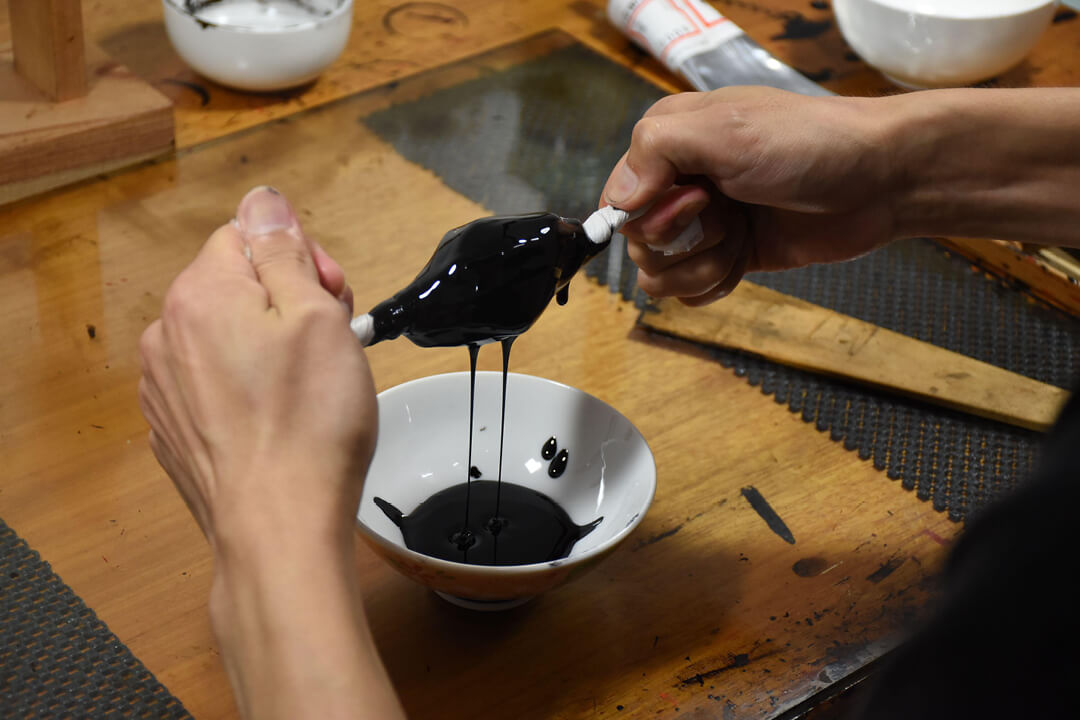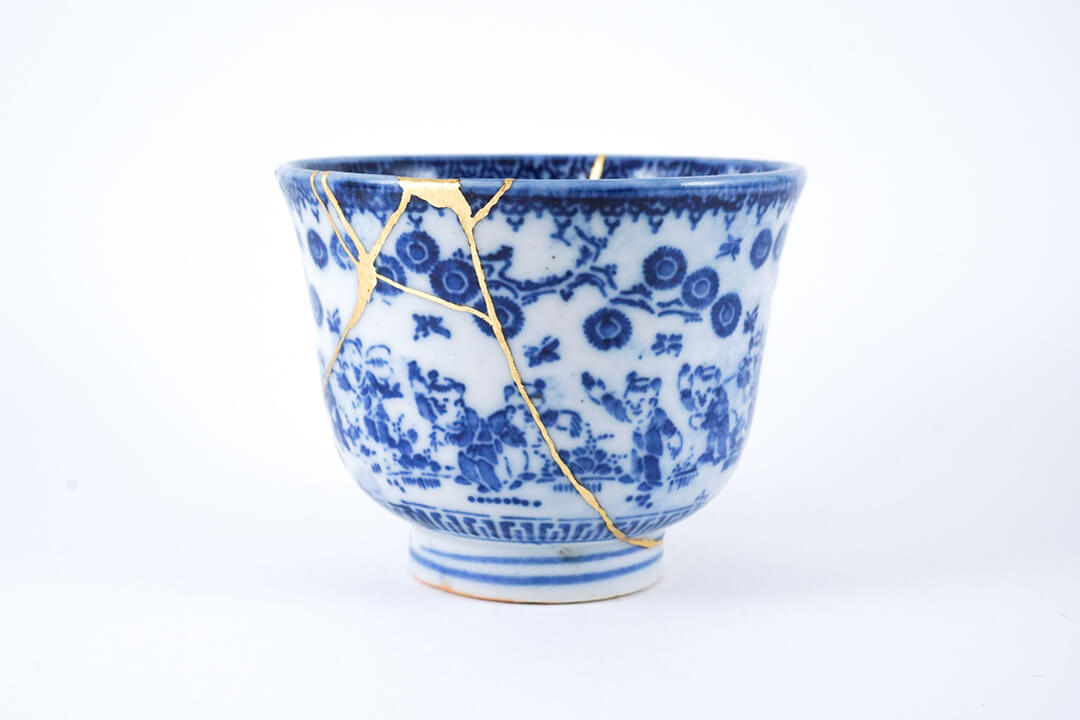With Kintsugi shards become beauties
Shards sometimes bring luck and with Kintsugi even more beauty
Repair with gold
The translation of the Japanese word Kintsugi is: repair with gold. The shards of broken porcelain or ceramic objects are traditionally reassembled with urushi, a kind of varnish obtained from the sap of the urushi tree.
The broken areas are then made visible with dust of gold, silver or brass, giving the broken object a special aesthetic appeal,
Of the value of things
What sounds like a mundane do-it-yourself method at first glance, opens up a fascinating insight into a profound way of looking at the value of objects at second glance.
Even the sight of a bowl made of ceramics, porcelain or wood, the manufacture of which required special skills, can be the first part of enjoying a portion of rice, soup or tea.

The eye is and drinks first
The connoisseur of the Japanese tea ceremony is familiar with the fact that first the tea bowl is carefully considered. This is a way to honor the craftsman and/or artist who created the tea bowl.
Japanese tales from earlier centuries, designed to increase appreciation for the making of handcrafted items, tell of a noble man who cared for nothing so much as the beauty of a special tea bowl and of his great desire that this tea bowl would be equally appreciated by his visitors.
One day he invited the most famous tea master of the country to serve him tea in this exceptionally beautiful tea bowl.
However, the tea master did not express any appreciation for the tea bowl with a single word. Thereupon, the host angrily smashed the tea bowl, which broke into shards.
Attendees who observed this collected the broken pieces and had them repaired at great expense, and served tea again to the famous tea ceremony master in the restored tea bowl, whereupon he exclaimed, “Now this bowl is magnificent.”
Do not cover up the breach
Emphasizing the fractures of an object with gold or silver does not want to cover up, but to point out the history of the object.
Depending on the materials used, the items may still be suitable for eating or drinking, or they may henceforth be used solely for beauty, because materials may be used that are not food safe.
No longer whitewashing fractures or destruction has long been a trend in the restoration of historic structures. They thus acquire an aesthetic of their own and become contemporary witnesses.
The joy of breaking points can be applied to many areas. Many a friendship also survives a break and wins through it.
People with breaking points are usually the more interesting conversational partners.
The special tree sap: Urushi
To repair porcelain or ceramics, the sap of urushi trees is used in the Japanese kintsugi tradition. A repair with processed Urushi juice can take two to three months due to the multiple drying times required.
 Filtration of Japanese lacquer urushi © Magdalena Kozar / Alamy Stock Photo
Filtration of Japanese lacquer urushi © Magdalena Kozar / Alamy Stock Photo
Is it worth the effort?
Depends on the setting. Quite a few people own a box in which they keep the shells of a broken object, from which they do not like to part, because many precious memories are associated with it.
With a Kintsugi repair, these emotional treasures are given a new lease on life.
Kintsugi finds more and more followers even among laymen. People who enjoy putting things back together and who enjoy handling small spades, knives and brushes.
Since the prepared urushi juice, which should be processed quickly, is not so easy to obtain outside Japan and the work is time-consuming due to the multiple drying of individual layers, laymen sometimes work alternatively and pragmatically with epoxy resin.
Urushi instead of plastic
If you are one of those cautious people who are careful with their precious porcelain pieces and Kintsugi is out of the question for you, then the Urushi lacquer used in this technique might still be of interest to you.
Urushi bowls, bowls made from wood and lacquered with a fine layer of urushi, are ideal for holding food like a portion of rice or porridge in them from the first bite to the last, why.
The use of urushi has been known in Japan for about 9000 years. Once upon a time, valuable swords and armor were covered with urushi. Items made of Urushi last for several generations. Only UV light is harmful to them and shortens the life of centuries to decades.
However, if one day you no longer want to see the objects, composting is not a problem. Unlike the recycling of plastic or items that have been coated with conventional paints, Urushi items, which are made of purely plant-based basic components, can be composted without hesitation.
London Japan House
For all Japan lovers, London Japan House, is an interesting place to learn more about Japan. As of 2018, London Japan House is located at 101-111, High Street Kensington. Admission is free of charge. There are exhibitions, interesting lectures, courses, a takeaway café and a restaurant.
 There are two other houses of this type in Los Angeles and São Paulo. You can’t market Japan more perfectly than that.
There are two other houses of this type in Los Angeles and São Paulo. You can’t market Japan more perfectly than that.
Online, you can buy Urushi Bowls at the museum store there.
If you are interested in handcrafted art and want to experience an Urushi artist whom the Japanese government has named a “Living Preserver of the National Art Treasure,” you can see Murose Kazumi at work with Urushi in this beautiful film. Pure aesthetics.
Basketball – Kintsugi Court
Kintsugi is by no means the domain of Japanese-inspired porcelain lovers. American artist and filmmaker Victor Salomon combines Kintsugi with basketball in his art project “Literally Balling.”

At the end of the COVID pandemic, during which basketball games could no longer be played, he repaired the cracks of a Los Angeles basketball court with a gold-colored resin to draw attention to the integrating power of the sport and the need to heal the scars COVID had left. Kintsugi Court – Kintsugi meets Basketball. To see at mymodernmet.com
Cover picture, Antique Kintsugi © Marco Montalti / White bowl Kintsugi © Alamy Stock Photo




